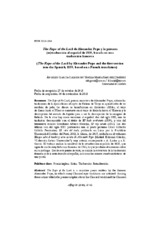The Rape of the Lock de Alexander Pope y la primera (re)traducción al español de 1839, basada en una traducción francesa
The Rape of the Lock by Alexander Pope and the first version into the Spanish, 1839, based on a French translation
Autor
García Calderón, Ángeles
Sánchez Jiménez, Emilia María
Editor
UCOPressFecha
2018Materia
Poesía inglesaSátira
Traducción
Retraducción
English poetry
Satire
Translation
Retranslation
METS:
Mostrar el registro METSPREMIS:
Mostrar el registro PREMISMetadatos
Mostrar el registro completo del ítemResumen
The Rape of the Lock, poema narrativo de Alexander Pope, satiriza las tradiciones de la épica clásica: el rapto de Helena de Troya es aquí el robo de un mechón de pelo; los dioses se transforman en diminutas sílfides; el viaje de Eneas hasta el Tíber se convierte en el viaje de Belinda hasta el Támesis y la descripción del escudo de Aquiles pasa a ser la descripción de las enaguas de Belinda. De la obra hay cinco versiones al español: dos del siglo XIX, una de traductor desconocido con el título de El bucle arrebatado (1839), y otra del humanista canario Graciliano Afonso Naranjo, El rizo robado (1851). Las dos últimas son del siglo XXI: pertenecen una al poeta peruano César Gilberto Saldaña Fernández, El robo del bucle, publicada en Lima por la Pontificia Universidad Católica del Perú, 2002; la última, de 2017, incluida en el volumen Ensayo sobre el hombre y otros escritos de Alexander Pope (Madrid: Editorial Cátedra, “Colección Letras Universales”) cuya autoría corresponde a A. Lastra y a Á. García. El trabajo analiza la similitud de la retraducción española de 1839, que sigue de modo muy fiel a una francesa de 1763, lo que ya afirma el anónimo autor en su prólogo. Desde este punto de vista, se analiza la estructura de la traducción francesa y de la retraducción al español, así como los errores morfosintácticos de una y otra. The Rape of the Lock is a narrative poem written by the famous Alexander Pope, in which many Classical epic traditions are satirized. Among those satires which the poem compiles about the Classical world and the Classical tradition arise such as the abduction of Helen of Troy, which is now reproduced in verses by means of the robbery of the lock; Gods are turned into miniscule sylphs; Aenea’s voyage across the Tiber is compared to Belinda’s journey throughout River Thames; or the description of Achilles’s Shield, which is equivalent now to the description of Belinda’s petticoats. There are five available versions of the original poem into the Spanish language: two of them date from the nineteenth-century; the first one —from anonymous translator, is entitled El bucle arrebatado (1839), meanwhile the second one was carried out by the Canaryan humanist Graciliano Afonso, El rizo robado (1851). The last two versions of the poem go back to the twenty-first century; the first one belongs to the Peruvian poet César Gilberto Saldaña Fernández, El robo del bucle, which was published by the Catholic University of Peru, 2002, Lima. Finally, the last version of the original poem dates from 2017, and it is included in the volume Ensayo sobre el hombre y otros escritos de Alexander Pope (Madrid: Editorial Cátedra, “Colección LetrasUniversales”) by A. Lastra y Á. García. The essay is focused on the examination of the similitude which the Spanish retranslation (1839) shares with the former and original French version (1763), which is faithfully imitated by the anonymous Spanish author as he declares in the prologue to his poem. From this view, both —the structure of the French translation and its re-translation into Spanish, as well as those morphosyntactic errors included along —the poem are analysed.

